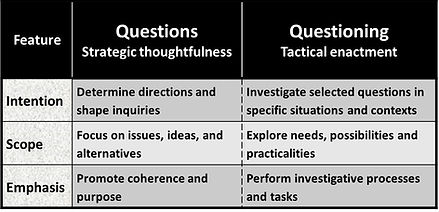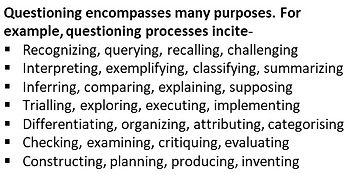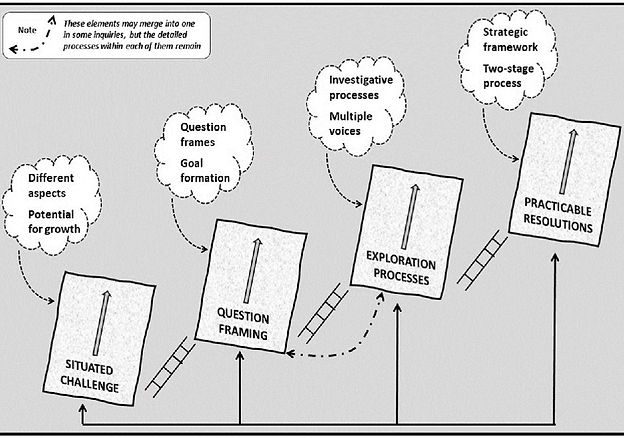
Design processes

Sensemaking
This life-long process is driven by curiosity and its agent questions. Together they represent 'question sense' through which people come to understand their experience and address challenges in their everyday lives. When enacted through a mindset of inventive inquiry human capacity flourishes.
Curious questions
To ask a question is to see both backward and forward – to make sense of a thing and what you know about it, and then extend outward in space and time to imagine what else can be known, or what others might know.
To ask a great question is to see the conceptual ecology of the thing.
TeachThought
Framing questions
It is important to distinguish between questions and questioning. They are not the same. Although they are partners in inquiries. Key differences are set out in the table.
Framing question-led inquiries has three iterative elements which are usually played out in sequence. These are - generic generative questions, consequent questions, and pointed questions. These questions are open-ended, each with multiple answers.
Closed questions are different as they elicit a single response - for example, 'what is the time now'?


Asking questions can be general or specific.
While the choice of a question or questions depends on intention and circumstance, the process has an evolving pattern.
-
Generic generative questions (GGQs) which can be applied across all areas of human experience and endeavor. They direct inquiries.
-
Consequent questions (CQs) which emerge when GGQs are translated into the content of an inquiry. They explore different aspects of an inquiry.
-
Pointed questions (PQs) which are narrowly focused. They investigate specific aspects of an inquiry.
GGQs, CQs and PQs are a package. They are a means for 'framing of questions' through
which curiosity and inventiveness can flourish. The process is iterative, not a mechanism.
Generic Generative questions

Click the image to expand
Consequent questions and Pointed questions
Broad questions
Wonderment questions involve comprehension, prediction, anomaly detection, application, and strategizing or planning when no procedure is given
Vexing questions are borne on intellectual dissonance that incites challenge or contradiction in response to specific lines of thinking or action
‘What if’ questions stimulate imagination and creativity without any precedent or examples to draw on
Exploratory questions seek to explore or unfold the extent of new knowledge …
Text-based questions are a response to reading texts and knowledge-based information …
Investigative questions engage learners in designing and performing ‘hands-on’ or 'second-hand' inquiries …
Confirmation questions seek to clarify information and transform understanding …
Input questions recall information and construct ideas and relationships …
Consolidation questions seek to expand new ideas and reconcile differences …
Misunderstanding questions explore misconceptions and complexities …
Hierarchical questions focus on increasingly sophisticated cognitive processes …
‘Deep reasoning’ questions explore antecedents, consequences, procedures, and actions …
Reflective questions are constructively critical to review or change mindsets
Focused questions
Twelve generic generative questions (GGQs) that cover the broad range of human endeavor.
Select two or three of the most relevant for the content and context of the inquiry at hand.
Translate GGQs into-
Consequent questions (CQs)
and
Pointed questions (PQs)
Questioning processes
Questioning processes enact inquiries by transforming selected GGQs, CQs and PQs
into performances


Framing inquiries
Start by reviewing or analyzing the situation or context of an inquiry to determine its key features. With this scenario in mind launch into a two-cycle inventive process of 'discovery and design' followed by 'develop and enact'. An overview of the process is illustrated below.

Click the image to expand
The package of questions - GGQs, CQs and PQs - at the centre of each cycle flows iteratively in the direction of the arrows.
-
Inquiries in a design and discovery cycle focus on generating ideas, and possibilities. In the process curious connections are made which incite strategic design ideas.
Once these strategic design ideas have realistic potential
-
Inquiries evolve into a develop and enact cycle to devise actions, processes and solutions. In the process curious connections are transformed into inventive or creative outcomes.
The questions in the frames in the middle of each cycle often change with the evolution in focus. The whole process provides a flexible structure for designing and implementing question-led inquiries. The outcomes may be creative innovations or imaginative improvisations as well as transformations of current or previous ideas and practices.
A two-cycle inventiveness process is not confined to scientific and technological innovation. It is equally valuable when writing a book, composing a piece of music, solving an everyday problem, developing a business enterprise, painting a picture, creating a drama, or even quietly reflecting on experience.
Scaffolding inquiries
If language requires structure, the development of question-led learning might also be aided by a flexible yet coherent architecture. Four elements form a doable design for scaffolding inquiries.
-
Situation analysis
-
Question framing,
-
Exploration processes
-
Practical inventiveness
The process is iterative, not a mechanism. An overview of the scaffolding process is shown in the diagram.


Click the image to expand
Thinking growth?
Ask a new question, and in so doing change the basis on which old questions have been framed.
True across education, business and community activities?
Questions, curiosity, inquiry, inventiveness, collaboration, cooperation, learning, teaching, expertise, talents, community, development, challenge, co-design, co-construction





